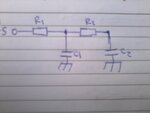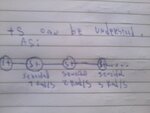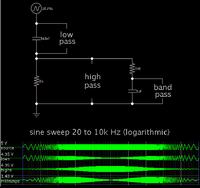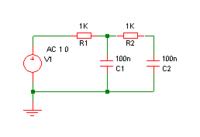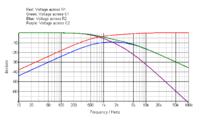AlephUser
Newbie level 4
Hey there, I'm working on a project where I need to take a signal and "separate" it into three small signal bands. As I'm working it right now:
I have a signal +S. In series, there's a resistor R1, a resistor R2 and a capacitor C2. But, between R1 and R2 there's a node with another capacitor, C1, connected in the ground.
The idea is that the mash S ~ R1 ~ C1 ~ GND forms a low pass filter. So the voltage at R1 would be the higher harmonics of S1.
In contrast, the voltage at C1 would represent the other harmonics, because it's E - VR1.
But as C1 is in parallel with the mash R2 ~ C2 ~ GND then this would form a second filter with input voltage VC1.
Then, VR2 would again represent the higher harmonics, but as the first filter already got the highest harmonics, VR2 would represent median harmonics.
Finally, the lowest harmonics would be in VC2.
That principle sounded okay at my mind, but I wasn't so sure so I googled around for "Low-Pass Filter in Series" and stuff like that. The problem is: I didn't managed to find anything. When I learned filters I didn't used notations as grounds and didn't needed concepts like harmonics. So I really don't know if that idea is right or if it's wrong. Could you guys help me?
Notes: I'll try to draw the scheme and post it here as soon as possible. Also, I'm trying to work with an audio signal amplifier project, so any ideas are welcome!
Thanks in advance!
I have a signal +S. In series, there's a resistor R1, a resistor R2 and a capacitor C2. But, between R1 and R2 there's a node with another capacitor, C1, connected in the ground.
The idea is that the mash S ~ R1 ~ C1 ~ GND forms a low pass filter. So the voltage at R1 would be the higher harmonics of S1.
In contrast, the voltage at C1 would represent the other harmonics, because it's E - VR1.
But as C1 is in parallel with the mash R2 ~ C2 ~ GND then this would form a second filter with input voltage VC1.
Then, VR2 would again represent the higher harmonics, but as the first filter already got the highest harmonics, VR2 would represent median harmonics.
Finally, the lowest harmonics would be in VC2.
That principle sounded okay at my mind, but I wasn't so sure so I googled around for "Low-Pass Filter in Series" and stuff like that. The problem is: I didn't managed to find anything. When I learned filters I didn't used notations as grounds and didn't needed concepts like harmonics. So I really don't know if that idea is right or if it's wrong. Could you guys help me?
Notes: I'll try to draw the scheme and post it here as soon as possible. Also, I'm trying to work with an audio signal amplifier project, so any ideas are welcome!
Thanks in advance!
